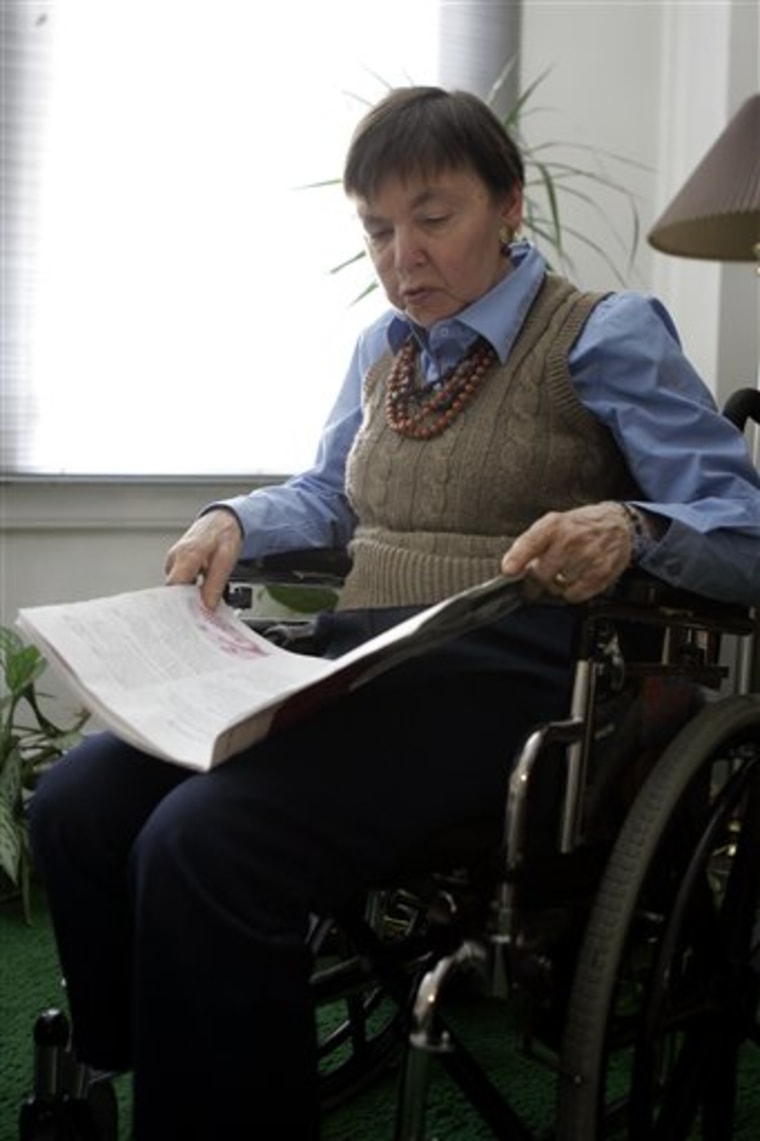Kathy Leeds grows animated as she describes the courses she is taking this fall, including classes in current events, art and literature.
But Leeds will never step foot on a campus or in a classroom. The 79-year-old widow has multiple sclerosis, uses a wheelchair and is confined to her Manhattan apartment.
Leeds is one of about 500 people enrolled for the fall semester in a telephone-based educational program for homebound seniors called DOROT University Without Walls, believed to be the largest program of its kind in the country.
The curriculum includes more than 250 courses and runs the gamut from understanding feng shui and poetry writing to discussions on moral, ethical and philosophical issues and a discourse on women of the progressive era. Informational classes on money management, Internet surfing and medicine also are available.
"It gets me out emotionally. It releases me from the four walls around me," said Leeds, who has participated in the program for 12 years. Her fall selections include a course on the life and work of author Doris Lessing and a class on recording personal histories.
Majority of students from New York area
While the majority of the students are from the New York area, seniors in Alaska, Iowa and Texas also participate. The oldest was 105, but died last year.
As the nation's population grows older, Experts say programs like University Without Walls help engage seniors' minds and expand their social network by giving them something stimulating to do — factors helpful in diminishing the onset of depression, dementia and other ailments.
The latest Census figures show that 73 million Americans — nearly 20 percent of the total population, will be over 65 by 2030. Within that group, 35 to 40 percent will be over 85, said Dr. Leslie Libow, a geriatric specialist at the Jewish Home Life Care System affiliated with Mount Sinai School of Medicine.
The program was started in 1989 by DOROT, a New York-based senior services agency that partners with some of New York City's major medical and cultural institutions in offering the classes. They include Montefiore Medical Center, the Whitney Museum of American Art, the Museum of Modern Art and the Museum of Natural History; many provide free material in advance of a class, like large format art reproductions.
For 87-year-old Sarah Levinson, whose herniated disc and sciatica keep her from going out as much as she'd like, the breadth of the courses and their accessibility are unbeatable.
"When it's bad weather, cold, wet or hot, even when I don't feel well, I can get to the class," said Levinson, a Manhattan widow who's penned a poem on how the program rewards her personally. "The socialization, the interaction is wonderful."
Low fees, small classes
Marvin Cherner, 83, of Birmingham, Ala., took a series of classes on Parkinson's disease to learn more about how to manage the disease that afflicts him.
"It gave me an idea of what I face in the future," he said.
The classes are taught by professionals in the world of art, history, science and medicine who often volunteer their time. Each 50-minute class meets once a week for up 18 weeks. Class size is kept small, no more than 10 people, to keep discussion lively. Fees also are low: $15 per course.
Outside experts and people involved with the program say it provides a hugely valuable service for homebound seniors.
"They say to me 'I have something to talk about now (with friends and family). I have a life. I don't have to wait for someone to take me out. I can just pick up the phone, and I'm there,'" said program director Bonnie Jacobs.
"It's an extraordinary way to combat a sense of isolation," said Nechama Liss-Levinson, a Long Island psychologist who introduced her mother-in-law to the program. "The idea that our bodies and our health are influenced by our emotional and intellectual well-being is well documented."
The program also provides a chance for the seniors to bring their personal experiences to the classroom.
"The work we're showing them is primarily from the 20th century, work that was created in many cases during the participants' lifetime so they are able to ... share insights that only they can share," said Francesca Rosenberg, head of MoMA's department of education, which will offer a class on artist Henri Matisse in December.
For example, she said, in looking at the painting "Broadway Boogie Woogie" by Piet Mondrian they can talk about what it was like to be in New York in the 1920s and go to the jazz clubs that inspired the artist's work.
Opportunity to meet others
Seniors say they also love the program because it allows them to meet people with similar interests. Many of them call each other outside the "classroom" to chat and check up on each other.
Instructors also form close relationships with their students, including Sam Merrin, owner of the Merrin Gallery of antiquities and pre-Columbia art in Manhattan, who teaches a class on art collecting and another on trends in the art world.
Merrin said he often forgets about his students' frailty because of their exuberance. When two of his longtime students, Marion and Ethel, died last year, he said, "It hit me very hard."
Although he had never met Marion in person, he said, the 90-plus widow frequently e-mailed him after class. Ethel, who was in her 80s, even took his class after moving to Israel.
"Those two deaths affected me where, literally, I took this semester off. I didn't figure on this," he said. "You forget they're elderly."
Jacobs says she has her own proof of the vigor that the participants bring to the program: "Some people put on their lipstick even though no one can see them."
